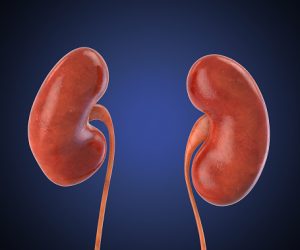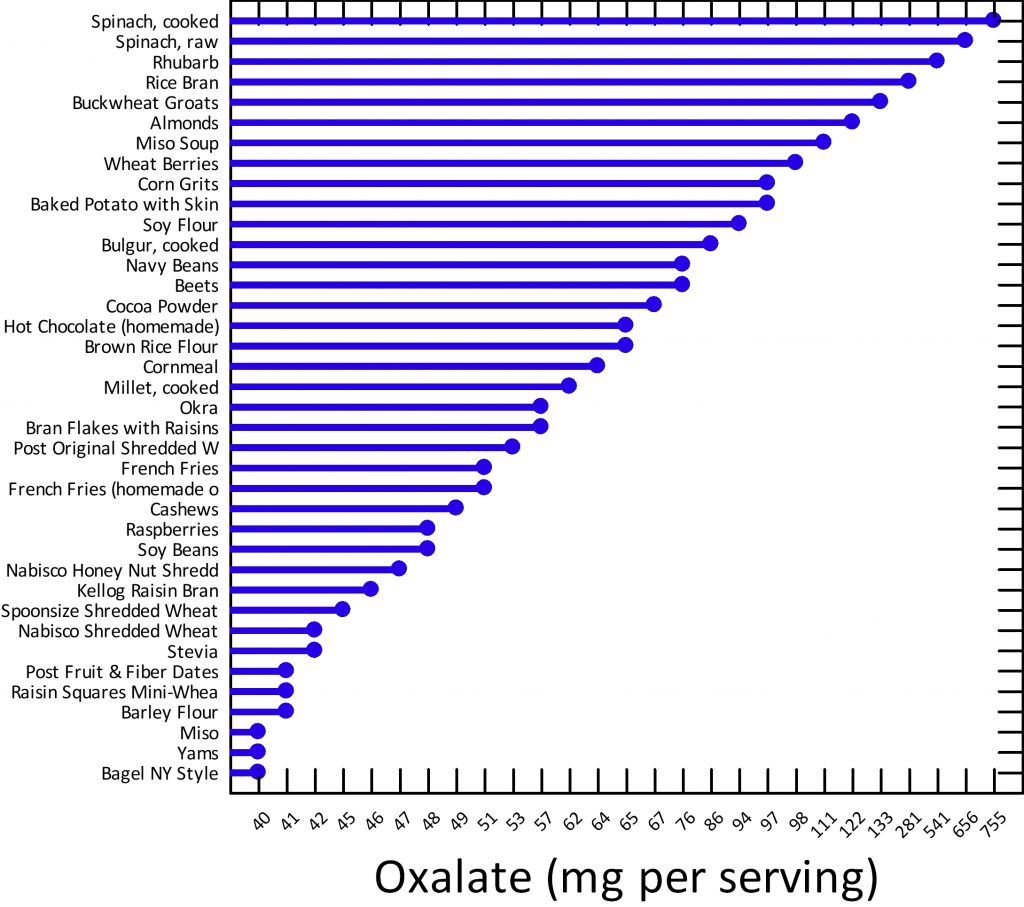 Calcium oxalate stones are the most common type of kidney stone affecting western society. In the United States alone, about one million people develop kidney stones every year, with adults between the ages of 20–40 most commonly affected. To help mitigate the risk of developing calcium oxalate stones, in particular, it is recommended to limit oxalate in the diet to 40–50mg/day.
Calcium oxalate stones are the most common type of kidney stone affecting western society. In the United States alone, about one million people develop kidney stones every year, with adults between the ages of 20–40 most commonly affected. To help mitigate the risk of developing calcium oxalate stones, in particular, it is recommended to limit oxalate in the diet to 40–50mg/day.
In plants, oxalate helps remove excess calcium, hence their high oxalate content. For humans, oxalate may work as a “prebiotic”, meaning it contributes to good bacteria within the gut.
Advertisement
When oxalate is ingested with the food, it gets broken down by the digestive system and released through our stool or urine. On its way through the intestines, oxalate can bind with calcium and get excreted through our stool. But when high levels of oxalate continuously pass through the kidneys, this is when kidney stones can develop. Calcium oxalate kidney stones are the most common kidney stone variety.
Low oxalate diet: High oxalate foods to avoid
As mentioned, some food items, mainly plant-based, contain high levels of oxalate. Here are the most common foods that contain oxalate along with their oxalate levels.
.table-div{ width:100%; border-collapse:collapse; margin:0 auto; padding-top: 20px; }
.table-div tr{ background: #b8d1f3;}
.table-div tr td:nth-child(odd){ background: #e9e9e9; }
.table-div tr td:nth-child(even){ background: #fff; }
.table-div table th { background:#6a813d; padding:10px 0; border:1px solid #fff; font-weight:bold; color:#fff; text-align:center;border-bottom: 1px solid #000; }
.table-div table td{border: 1px solid #000; padding:10px 6px;}
.table-text-center{text-align:center;}
.table-text-left{text-align:left;}
| Food Item | Serving (oz) | Oxalate Content (mg) |
|---|---|---|
| Beet greens, cooked | 1/2 cup | 916 |
| Rhubarb, stewed, no sugar | 1/2 cup | 860 |
| Spinach, cooked | 1/2 cup | 750 |
| Chard, Swiss, leaves cooked | 1/2 cup | 660 |
| Rhubarb, canned | 1/2 cup | 600 |
| Spinach, frozen | 1/2 cup | 600 |
| Poke greens, cooked | 1/2 cup | 476 |
| Dandelion greens, cooked | 1/2 cup | 246 |
| Kale, cooked | 1/2 cup | 125 |
| Turnip greens, cooked | 1/2 cup | 110 |
| Collard greens, cooked | 1/2 cup | 74 |
| Broccoli, cooked | 1 large stalk | 6 |
Prevent kidney stones with low-oxalate diet
In order to best prevent kidney stones, it’s essential to consume a low-oxalate diet. Here is a chart that outlines the food and beverages to avoid, limit, and consume on a low-oxalate diet.
| Foods to avoid (High oxalate) | Foods to minimize (Medium oxalate) | Foods to eat (Low oxalate) |
|---|---|---|
| Dark or “robust” beer Black tea Chocolate milk Cocoa Instant coffee Hot chocolate Juice made from high oxalate fruits Ovaltine Soy drinks Chocolate milk Soy cheese Soy milk Soy yogurt Nuts Nut butters Sesame seeds Tahini Soy nuts Amaranth Buckwheat Cereal (bran or high fiber) Crisp bread (rye or wheat) Fruit cake Grits Pretzels Taro Wheat bran Wheat germ Whole wheat bread Whole wheat flour Blackberries Blueberries Carambola Concord grapes Currents Dewberries Elderberries Figs Fruit cocktail Gooseberry Kiwis Lemon peel Lime peel Orange peel Raspberries Rhubarb Canned strawberries Tamarillo Tangerines Beans (baked, green, dried, kidney) Beets Beet greens Beet root Carrots Celery Chicory Collards Dandelion greens Eggplant Escarole Kale Leeks Okra Olives Parsley Peppers (chili and green) Pokeweed Potatoes (baked, boiled, fried) Rutabaga Spinach Summer squash Sweet potato Swiss chard Zucchini Black pepper (more than 1 tsp.) Marmalade Soy sauce Chocolate Parsley | Draft beer Carrot juice Brewed coffee Cranberry juice Grape juice Guinness draft beer Matetea tea Orange juice Rosehip tea Tomato juice Black currant tea Yogurt Flaxseed Sunflower seeds Apples Applesauce Apricots Coconut Cranberries Mandarin orange Orange Fresh peaches Fresh pear Pineapples Purple and Damson plums Prunes Fresh strawberries Liver Sardines Bagels Brown rice Cornmeal Corn starch Corn tortilla Fig cookie Oatmeal Ravioli (no sauce) Spaghetti in red sauce Sponge cake Cinnamon pop tart White bread Artichoke Asparagus Broccoli Brussel sprouts Carrots (canned) Corn Fennel Lettuce Lima beans Mustard greens Onions Parsnip Canned peas Tomato Tomato soup Turnips Vegetable soup Watercress Ginger Malt Potato chips (less than 3.5 oz.) Strawberry jam/preserves Thyme
| Apple cider Apple juice Apricot nectar Bottled beer Cherry juice Cola Grapefruit juice Green tea Herbal teas Lemonade Lemon juice Limeade Lime juice Oolong tea Pineapple juice Wine Herbal tea Cheese Buttermilk Milk Butter Margarine Mayonnaise Salad dressing Vegetable oil Avocados Bananas Cherries (bing and sour) Grapefruit Grapes (green and red) Huckleberries Kumquat Litchi/Lychee Mangoes Melons Nectarines Papaya Passion fruit Canned peaches Canned pears Green and yellow plums Raisins (1/4 cup) Bacon Beef Corned beef Fish (except sardines) Ham Lamb Lean meats Pork Poultry Shellfish Barley Cereals (corn or rice) Cheerios Chicken noodle soup Egg noodles English muffin Graham crackers Macaroni Pasta (plain) White rice Wild rice Cabbage Cauliflower Chives Cucumber Endive Kohlrabi Mushrooms Peas Radishes Water chestnut Basil Cinnamon Corn syrup Dijon mustard Dill Honey Imitation vanilla extract Jelly made from low oxalate fruits Ketchup (1 tbsp.) Maple syrup Nutmeg Oregano Peppermint Sage Sugar Vinegar White pepper Gelatin (unflavored) Hard candy Jell-O Lemon balm Lemon juice Lime juice |

Credit: kidneystones.uchicago.edu
Low oxalate diet: Healthy eating guidelines to prevent kidney stones
Advertisement
Aside from eating a low-oxalate diet, there are other measures you can take in order to reduce your risk of kidney stones. Here are some healthy eating guidelines in order to prevent kidney stones.
- Drink plenty of water – carry around a refillable water bottle, add lemon to your water for flavor, set reminders to drink water.
- Avoid sugary beverages like soda or fruit juices.
- Limit animal protein – dietary guidelines recommend two to three servings of animal protein a day, opt for plant-based protein like beans.
- Limit sodium in your diet.
- Eat calcium-rich foods rather than taking supplements – adults over the age of 51 need 1,000 to 1,200 mg of calcium, which can be obtained through dairy products and some dark leafy greens.
- If you’ve previously had calcium-oxalate stones, limit high oxalate foods from your diet.
- Limit vitamin C supplementation to 1,000 mg a day and opt for food sources with vitamin C as opposed to supplementation.
- Avoid alcohol or limit your consumption to recommended guidelines of 10 drinks a week or no more than two drinks a day for women, and 15 drinks a week with no more than three drinks a day for men.
- Consume insoluble fiber as it helps reduce calcium in urine.
Tips to increase your fluid intake for kidney stones
 Drinking enough water is a great prevention method and can make passing of kidney stones easier, so ensure you are getting enough. For many of us, it’s difficult to get the proper amount of water, but these tricks can help you increase your hydration levels:
Drinking enough water is a great prevention method and can make passing of kidney stones easier, so ensure you are getting enough. For many of us, it’s difficult to get the proper amount of water, but these tricks can help you increase your hydration levels:
- Drink a large glass of water during specific times of the day, for example, when you wake up or after you urinate.
- Keep a large water bottle or mug near you at all times – at your desk, on your night stand, on a coffee table near the TV.
- Drink through a straw as it may help you drink more.
- Drink one glass of water each hour.
- When you have a food craving, drink water first as you may actually be thirsty not hungry.
- Add lemon or orange slices to your water for flavor and added health benefits.
- Drink two full glasses at each meal – one prior and one after.
- Carry a refillable water bottle with you, so if you run out of water you can just refill your bottle.
- Eat fruits and vegetables with a high water content like watermelon.
These tips can help you consume more water throughout the day, which will not only help prevent kidney stones but can improve overall health as well.
[adstoappear]